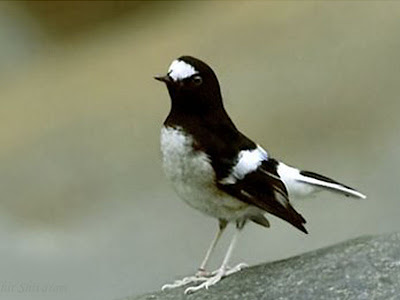The Little Forktail is a small (13 cm), very active black and white bird. Its forehead, rump, belly, undertail coverts and vent are white, while its head, chin, throat, nape, back and upper breast are black. A white bar across the wing extends across the lower back. The tail is notched, and is black in the centre with white outer feathers. Its iris is brown, its bill black and its feet a conspicuous pinkish-white. The Taiwan population has been named by some as a distinct subspecies, fortis, on the basis of its slightly larger size and more extensive white on the forecrown. However, these characters overlap with birds elsewhere in its range and no subspecies are currently recognized in the Handbook of the Birds of the World (Lynx Edicions).
The Little Forktail prefers rocky mountain streams in forested areas, especially near waterfalls. Its habitat ranges from very small streams a few metres across, to wide rugged rivers. The Little Forktail feeds on aquatic insects as well as crustaceans and some plant material. It feeds mainly by picking prey off wet rocks, sometimes standing in shallow rapids and even submerging itself to capture food. While moving about it frequently wags its tail slowly up and down or flicks it open, scissors-like. Its call is a short, high-pitched whistle.
The nest of the Little Forktail is a cup made of living moss, leaves and grass, lined with fine rootlets and leaf material, and usually placed in a rock crevice or on a mossy bank or ledge, often behind a waterfall. The female usually lays 3-5 eggs. Few details are known about incubation period, breeding behaviour and care of the young, and much remains to be discovered about this interesting species. In Taiwan the Little Forktail is a rare to uncommon bird in suitable habitat.





No comments:
Post a Comment